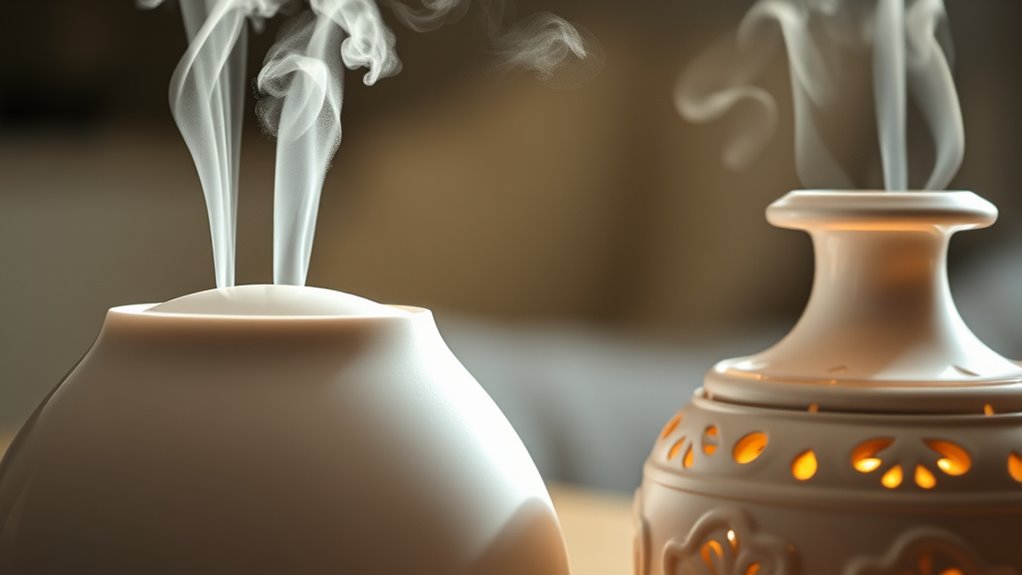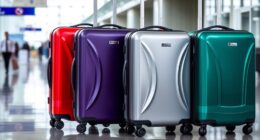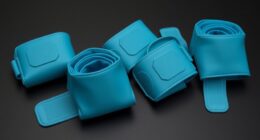Humidifiers add moisture by releasing cool mist through ultrasonic vibrations or filters, while vaporizers produce warm vapor by boiling water. Humidifiers are generally safer around children and easier to maintain, but vaporizers can help with congestion by emitting steam. Each option impacts your indoor air quality differently, and proper use is key to safety and effectiveness. If you want to know more about choosing the right device and its effects, there’s plenty to discover below.
Key Takeaways
- Humidifiers add cool moisture without heating, while vaporizers produce warm steam by boiling water.
- Vaporizers pose burn risks but can help with congestion; humidifiers are safer around children.
- Humidifiers use ultrasonic or wick filters, whereas vaporizers have metal coils for boiling water.
- Proper maintenance prevents bacteria buildup in both devices, ensuring better indoor air quality.
- Neither device cures illnesses; they mainly add moisture, so understanding their function is key for effective use.
How Humidifiers and Vaporizers Work Differently
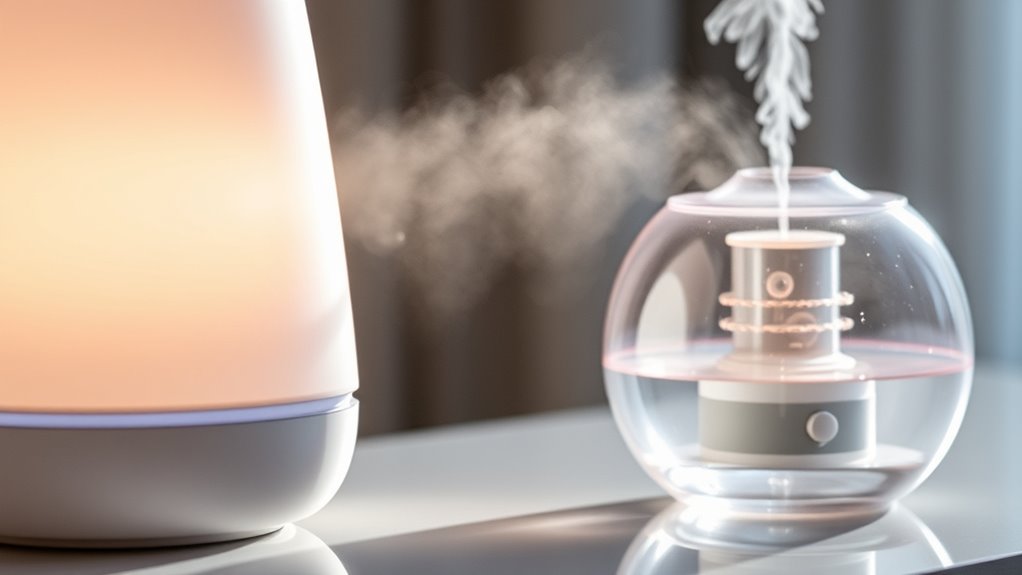
Humidifiers and vaporizers work differently because they generate moisture through distinct processes. A humidifier releases cool mist, which is created by ultrasonic vibrations or a wick filter that disperses water into the air without heating. This makes them safer around children and ideal for adding moisture without raising the room temperature. In contrast, a vaporizer produces warm vapor by heating water until it boils, releasing steam into the air. This warm vapor can help soothe congestion and keep the air moist, especially in colder weather. The key difference lies in how each device creates moisture: cool mist humidifiers use mechanical or ultrasonic means, while vaporizers rely on heating water to produce warm vapor. This fundamental difference influences their safety, effectiveness, and applications in your home.
Key Materials and Components of Each Device
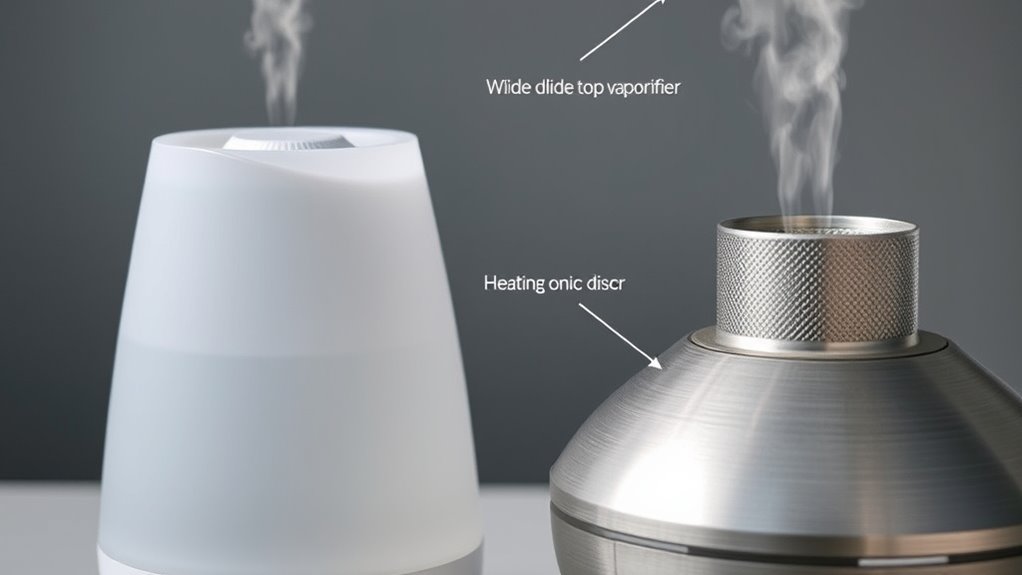
Understanding the key materials and components of these devices reveals how they function effectively and safely. Humidifiers and vaporizers rely on different parts to produce moisture, including water reservoirs, heating elements, and filters.
- Water reservoirs vary in size and material, impacting capacity and durability
- Filter types include wick filters, ultrasonic membranes, and activated carbon filters
- Heating elements in vaporizers use metal coils or plates to boil water safely
- Humidifiers may feature ultrasonic transducers or evaporative wicks
- Materials like plastic or metal are chosen for durability and safety, especially around water and heat
Knowing these components helps you select the right device for your needs and maintain it properly for optimal performance.
Safety Considerations for Home Use
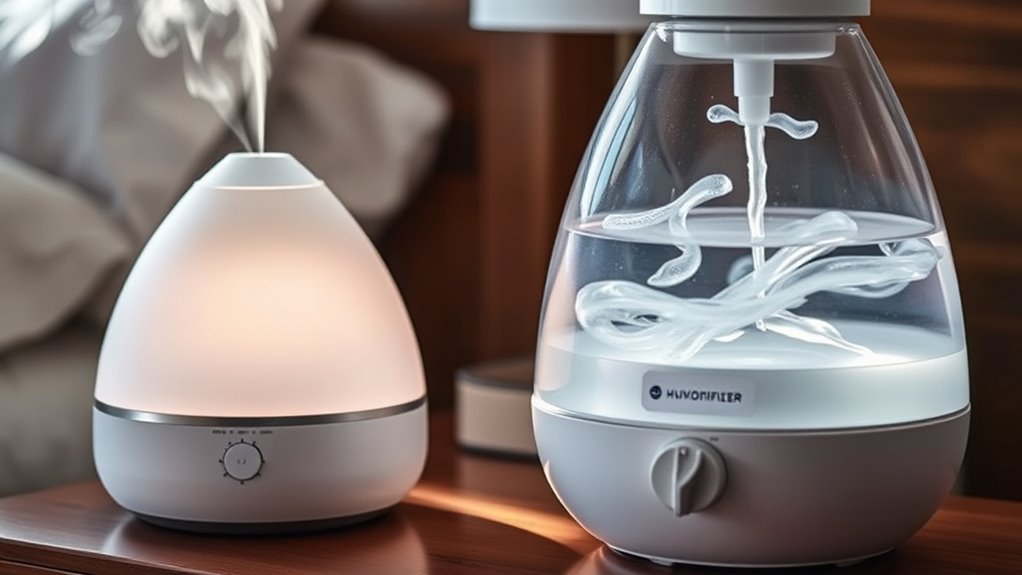
To guarantee safe use of humidifiers and vaporizers at home, you should be aware of potential health and safety risks. Child safety is a top concern, as both devices can pose hazards if not properly managed. Keep devices out of children’s reach to prevent burns from hot vaporizers or accidental spills. Be cautious of chemical risks, especially if using medicated or scented additives, which can irritate the respiratory system or cause allergic reactions. Always follow manufacturer instructions for cleaning and maintenance to prevent bacteria or mold growth. Use distilled or filtered water to reduce mineral deposits and airborne contaminants. Regularly inspect devices for damage, and never leave them unattended while in use. Staying vigilant minimizes risks and guarantees a safe, healthy environment.
Effects on Indoor Air Quality and Humidity Levels
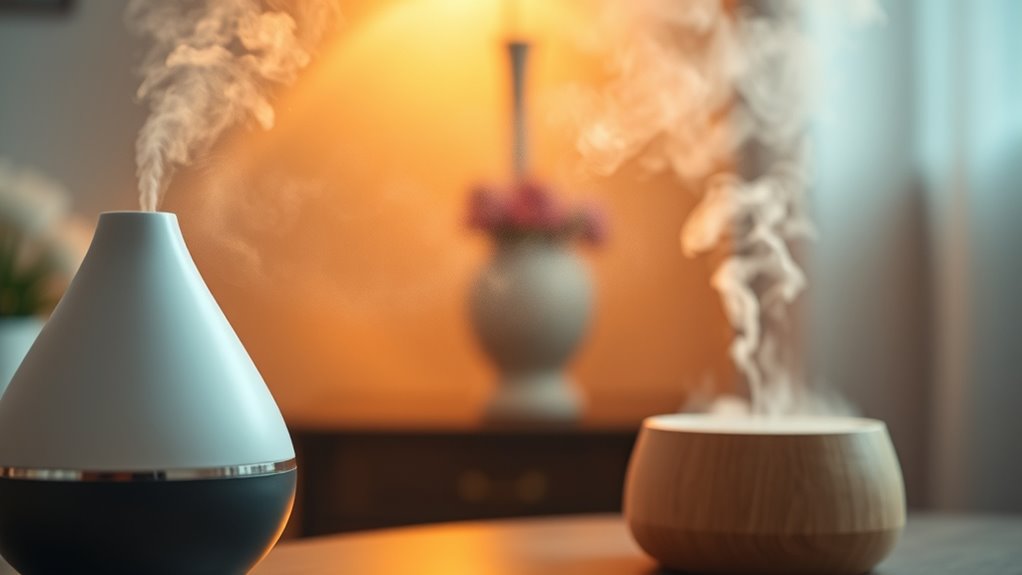
Have you ever wondered how humidifiers and vaporizers influence the air quality in your home? They notably impact humidity levels, affecting air purification and mold growth. Proper humidity helps reduce airborne pollutants and keeps your air fresh. However, excessive moisture can promote mold growth, worsening indoor air quality.
Consider these effects:
- Improved comfort with balanced humidity
- Enhanced air purification by trapping dust and allergens
- Increased risk of mold if humidity is too high
- Potential for bacteria and mold in unclean devices
- Better control of indoor air conditions
Choosing the right device and maintaining proper humidity levels ensures cleaner air and prevents mold, supporting a healthier living environment.
Impact on Allergies, Asthma, and Respiratory Health
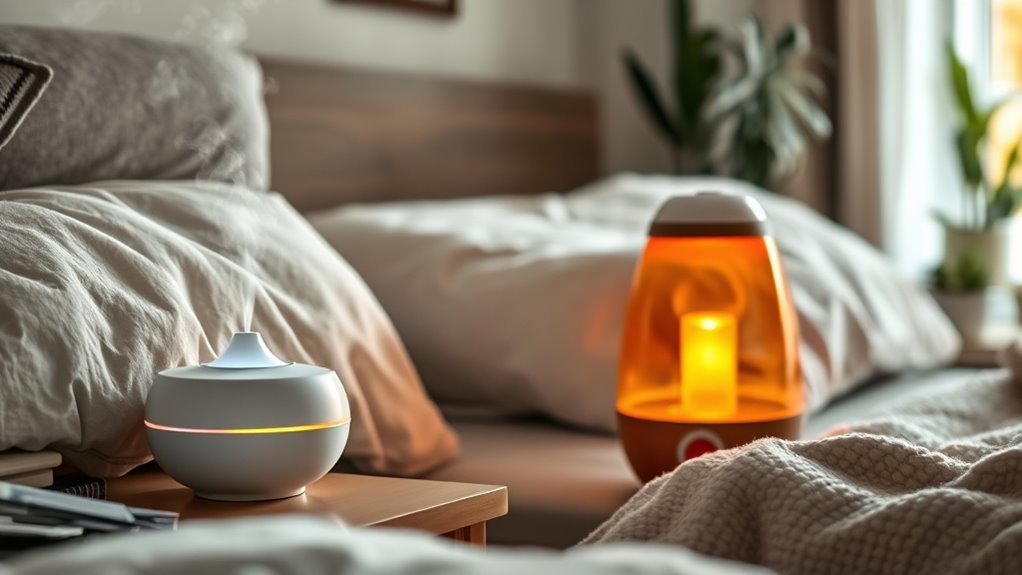
Humidifiers and vaporizers can substantially influence your respiratory health, especially if you suffer from allergies or asthma. Proper humidity levels help reduce airborne allergens like dust mites and mold, easing respiratory irritation. However, if not maintained well, these devices can circulate mold spores or bacteria, worsening symptoms. Vaporizers, which boil water to produce steam, tend to kill germs, potentially lowering airborne allergens. Conversely, humidifiers release cool mist, which can trap allergens if not cleaned regularly. Both devices can improve breathing comfort by preventing dry air that irritates your respiratory passages. Still, improper use or neglect can aggravate allergy symptoms or respiratory irritation. Choosing the right device and maintaining it properly are key to supporting your respiratory health effectively.
Maintenance and Cleaning Requirements
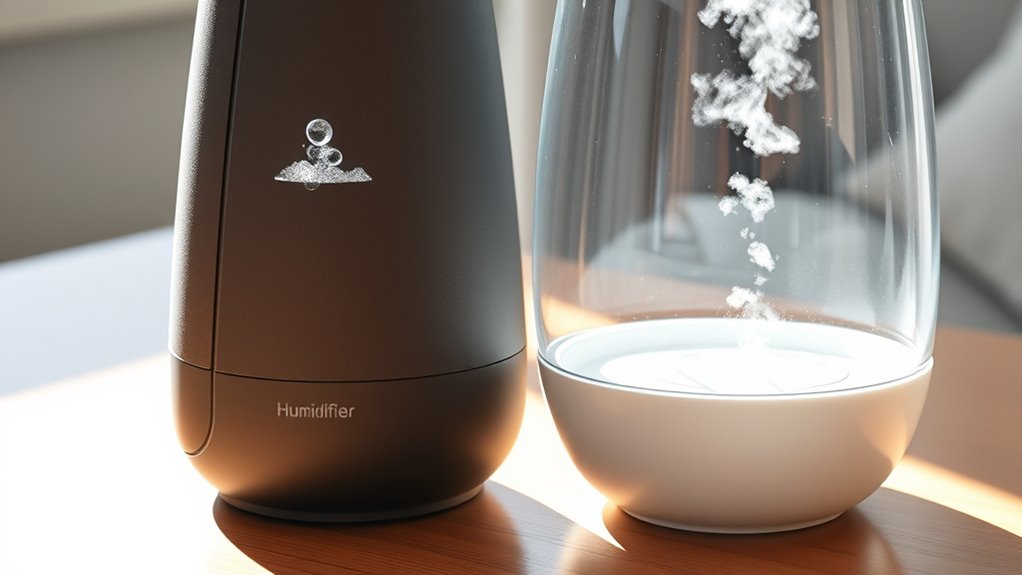
Regular maintenance and cleaning are essential to keep humidifiers and vaporizers functioning safely and effectively. Proper care prevents mold, bacteria buildup, and ensures peak performance. You should regularly check and replace filters according to the manufacturer’s recommended schedule, as outdated filters can harbor germs. Cleaning frequency varies: humidifiers often need weekly cleaning, while vaporizers may require more frequent attention. To maintain hygiene, empty water tanks daily and disinfect weekly with vinegar or a mild cleaner. Be sure to dry all components thoroughly before reuse. Additionally, keep an eye on the filter replacement schedule to avoid clogs or inefficiency. Proper maintenance not only prolongs device lifespan but also safeguards your health by reducing airborne contaminants.
- Check and replace filters regularly
- Clean water tanks weekly
- Disinfect with vinegar or mild cleaner
- Dry all parts thoroughly
- Follow manufacturer’s cleaning frequency guidelines
Energy Consumption and Operating Costs
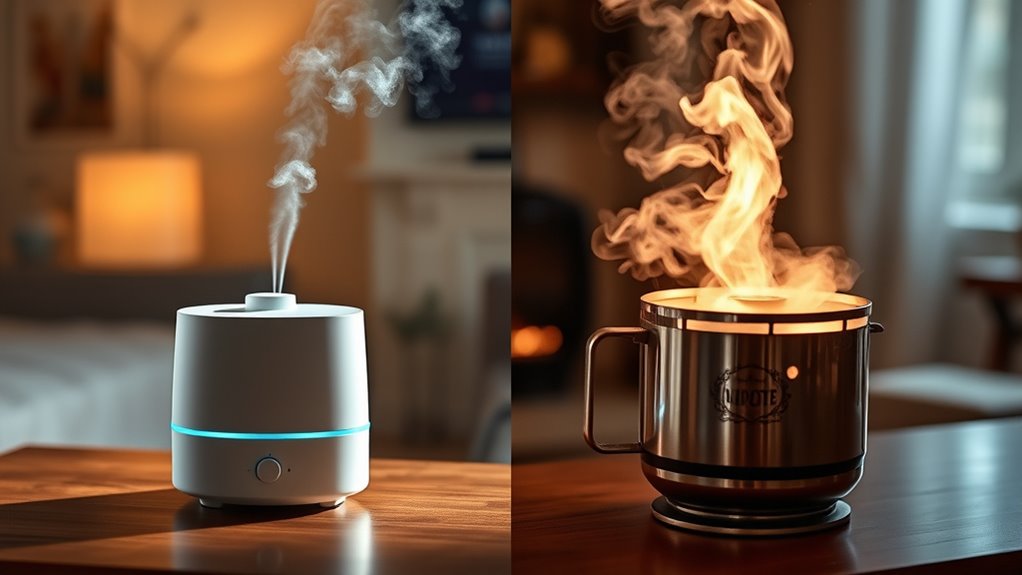
When it comes to energy consumption, vaporizers typically use less power than humidifiers because they heat water directly, which can be more energy-efficient. This process generally leads to lower electricity bills, making vaporizers a cost-effective choice if you’re mindful of operating costs. Humidifiers, especially ultrasonic or evaporative types, often run continuously and require less energy to operate, but their overall energy efficiency can vary based on models and settings. When comparing costs, consider the initial purchase price and ongoing electricity expenses. Vaporizers may save you money over time due to their energy-efficient design, but factors like maintenance and usage frequency also influence the total operating costs. Overall, vaporizers tend to be more economical in terms of energy consumption.
Ideal Environments and Situations for Each
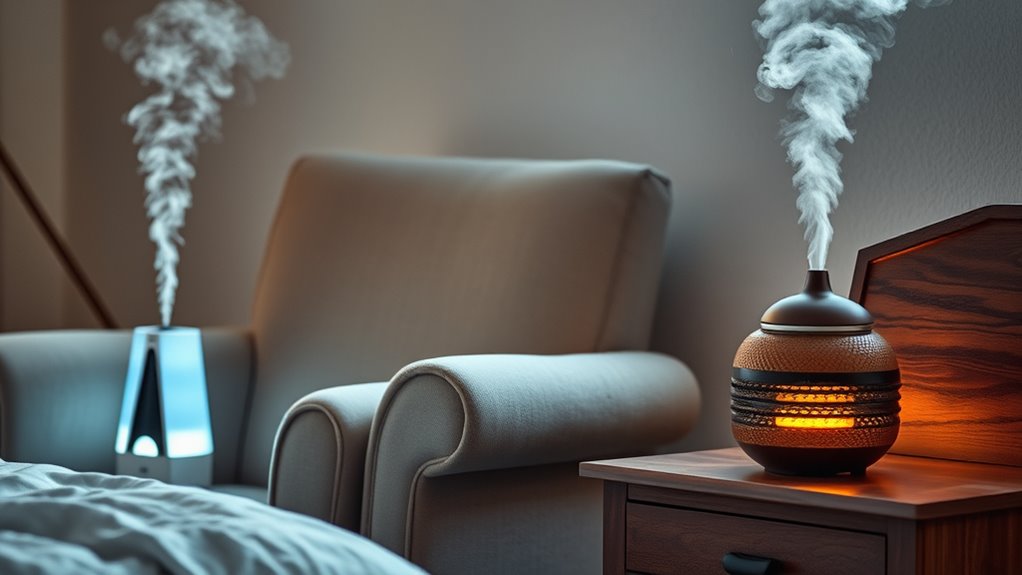
Choosing between a humidifier and a vaporizer depends largely on your specific environment and needs. Humidifiers work well in rooms where you want a subtle increase in moisture without disrupting room aesthetics or noise levels. They’re ideal for bedrooms, offices, or living spaces with delicate decor. Vaporizers, on the other hand, are better suited for situations demanding higher humidity, such as cold weather or respiratory relief, but they can be noisier and less discreet. Consider these factors:
- Room size and purpose
- Aesthetic preferences
- Noise tolerance
- Need for portability
- Safety considerations
Your choice hinges on balancing room aesthetics, noise levels, and the environment’s humidity requirements to optimize comfort and wellness effectively.
Common Misconceptions and Myths Debunked
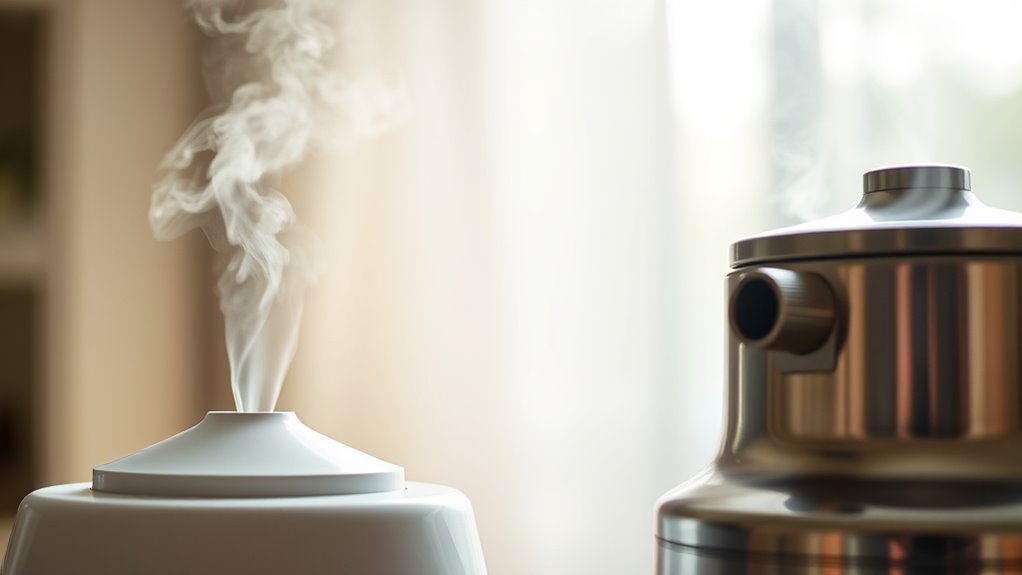
Many people believe humidifiers and vaporizers are interchangeable, but they serve different purposes and have distinct risks. You might also think that one type offers better health benefits, yet some claims are exaggerated or false. Let’s clarify these misconceptions to help you make informed choices.
Humidifier Vs Vaporizer Confusion
Despite common beliefs, humidifiers and vaporizers are often mistaken for each other, leading to confusion about their proper use and safety. Many assume that a humidifier vs vaporizer simply means moisture versus steam, but their functions differ markedly. Vaporizers produce steam, which can help with congestion, while humidifiers add moisture to the air without boiling water. Misunderstanding this can lead to safety risks or ineffective treatment.
- Vaporizers use boiling water, creating steam, while humidifiers add cool or warm moisture.
- Vaporizers may contain medicated vapors, unlike humidifiers.
- Steam can pose burn risks if mishandled.
- Humidifiers typically don’t disinfect water, risking bacteria growth.
- Choosing incorrectly can impact allergy relief or safety at home.
Health Benefits Misrepresented
There are numerous misconceptions about the health benefits of humidifiers and vaporizers, which can lead to ineffective use or even health risks. Many believe these devices automatically improve respiratory health, but that’s not always true. For example, improper use can compromise medication safety, making inhaled medicines less effective. Additionally, if you don’t clean your device regularly, bacteria growth can occur, potentially causing infections instead of preventing them. Vaporizers, in particular, aren’t a cure-all for colds or congestion; they only add moisture. Humidifiers can help but won’t eliminate airborne viruses or bacteria. Understanding these myths helps you use your device correctly and maintain a healthy environment, rather than falling for false claims about their health benefits.
Frequently Asked Questions
Can Humidifiers and Vaporizers Be Used Simultaneously?
Yes, you can use a humidifier and a vaporizer simultaneously, but be cautious. Doing so may enhance allergy relief and improve sleep by increasing moisture levels. However, make certain you’re not over-humidifying your space, which can promote mold or bacteria growth. Use both devices responsibly, monitor humidity levels, and clean them regularly to maintain a healthy environment that supports better sleep and allergy management.
Do Different Room Sizes Require Different Device Types?
Yes, different room sizes require different device types. For small rooms, choose a humidifier or vaporizer with a lower device capacity to prevent over-humidification. Larger rooms need a device with a higher capacity to evenly distribute moisture. Always check the product specifications for room size recommendations, ensuring you select a device that matches your room size for effective and comfortable humidity levels.
How Do I Choose Between a Cool Mist and Warm Mist Device?
Think of choosing between a cool mist and warm mist device like picking a cozy sweater or a invigorating breeze. If you want to boost air quality without extra warmth, go for a cool mist; it’s easier to maintain and safer around kids. Warm mist feels like a gentle hug but requires regular cleaning to prevent mineral buildup. Consider your comfort, safety, and maintenance tips to make the best choice for your home.
Are There Specific Brands Recommended for Safety and Effectiveness?
You should look for brands known for safety and high effectiveness ratings, like Honeywell, Vicks, and Dyson. These brands prioritize brand safety by using quality materials and reliable manufacturing standards. Check reviews and expert ratings to confirm their devices are effective at humidifying without leaks or mold issues. Investing in reputable brands helps you avoid safety hazards and guarantees that your humidifier or vaporizer performs well over time.
Can These Devices Help Prevent Colds or Flu?
Using a humidifier or vaporizer can support your immune system by maintaining ideal humidity levels, which may help reduce virus survival in the air. Keeping your indoor air moist can also soothe your respiratory tract, potentially lowering cold and flu symptoms. While they don’t guarantee prevention, these devices promote overall comfort, virus reduction, and immune support, especially during cold and flu season.
Conclusion
Choosing between a humidifier and vaporizer is like selecting a trusted compass for your home’s wellness journey. Each guides you through the fog of misconceptions toward clearer, healthier air. By understanding their differences, you harness their true potential—transforming your space into a sanctuary where comfort blooms and health flourishes. Remember, the right device isn’t just a tool; it’s a silent guardian, steering your environment toward harmony amid life’s inevitable storms.
